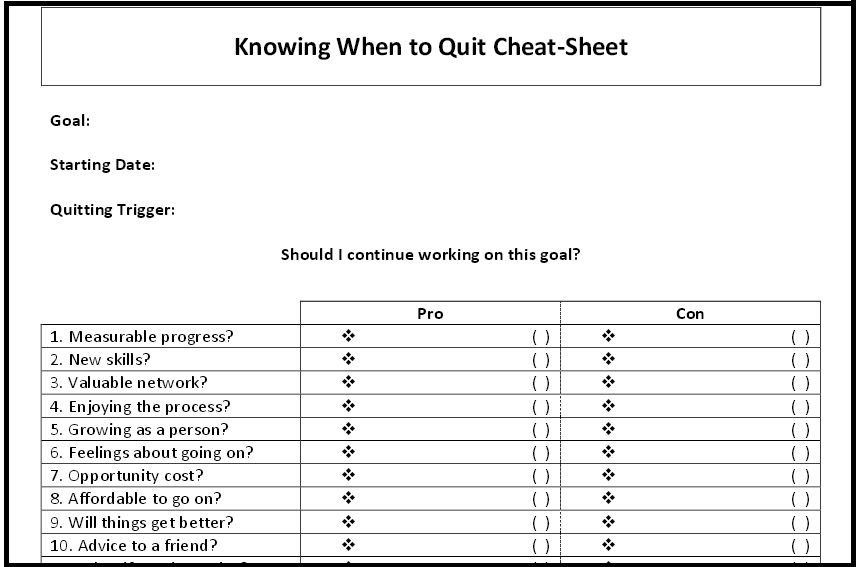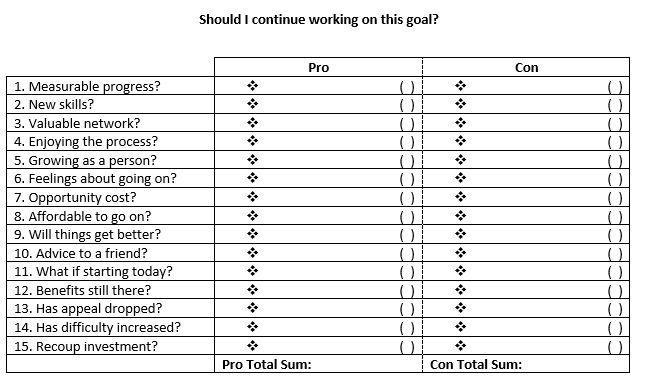
To be one of life’s winners, know when to quit.
You’ve probably read lots of quotes that paint the act of quitting in a negative light. Here are four examples:
- “If you quit once it becomes a habit. Never quit.” – Michael Jordan
- “It’s always too soon to quit.” – Norman Vincent Peale
- “Age wrinkles the body; quitting wrinkles the soul.” – Douglas MacArthur
- “Winners never quit and quitters never win.” – Vince Lombardi
 In addition, a couple of weeks ago I wrote a post titled “How to Not Give Up – 8 Strategies For Not Quitting.” So, why is this post about quitting? Because although grit and perseverance will get you almost anywhere, there are times when the best thing you can do is give up. The key lies in knowing when to keep going despite obstacles, setbacks, and disappointments, and recognizing when it’s time to throw in the towel.
In addition, a couple of weeks ago I wrote a post titled “How to Not Give Up – 8 Strategies For Not Quitting.” So, why is this post about quitting? Because although grit and perseverance will get you almost anywhere, there are times when the best thing you can do is give up. The key lies in knowing when to keep going despite obstacles, setbacks, and disappointments, and recognizing when it’s time to throw in the towel.
Quit Strategically
A few years back, the renown marketing expert Seth Godin published a book titled The Dip: A Little Book That Teaches You When to Quit (and When to Stick). In it, he offers a great primer on strategic quitting. Godin explains that, in order to know whether or not to quit, you need to determine if you’re in a “dip” or a “cul-de-sac”. Here’s the difference between the two:
- A “dip” is when the going gets tough, but there’s the opportunity to be the best in the world when you come up on the other side.
- A “cul-de-sac” is when you’re just going around in circles, and continued effort isn’t going to get you anywhere.
Godin explains that if you’re in a “dip” you should buckle down and keep going. But if you’re in a “cul-de-sac”, it’s time to wave a white flag. I agree with Godin’s analysis. The question then becomes:
How do you know when you’re in one of those situations in which you just need to keep going and you’ll achieve your goal, or when you need to face the fact the best thing you can do is give up?
In this post I’m going to share with you a cheat-sheet I developed for knowing when to quit. The process that you’ll be using to fill out the “Knowing When to Quit Cheat-Sheet” is the following:
- Choose a “Quitting Trigger”
- Make a List of Pros and Cons
- Brainstorm With the “15 Knowing When to Quit Questions”
The “Knowing When to Quit Cheat-Sheet” looks as follows (click on it to see it clearly):

You’ll find an explanation of the process that you’re going to use to fill out the cheat-sheet, below.
Choose a “Quitting Trigger”
The first thing that you’re going to do is decide ahead of time when you’re going to quit. An example of this is set forth in the book, The Battle For Investment Survival: How To Make Profits, written by Gerald M. Loeb.
In his book, Loeb explains that there’s a specific formula that you should use to maximize your gains and minimize your losses when you’re investing in the stock market. The formula works as follows:
- Select a stock to buy — make your selection based on rational fact-finding and expert counsel.
- The stock may rise for a short while, and then fall. In addition, the stock may rise for a long time. However, even if the stock does well for a prolonged period of time, you need to accept the fact that sooner or later the price of the stock will begin to fall.
- When the price starts to fall, wait for it to fall at least 10 to 15 percent. When it does, cut your losses. That is, sell out at the chosen percentage level.
What the formula is telling you is to decide ahead of time when you’re going to quit. You should apply this same principle to other areas of your life, including goal setting.
When you set a goal, decide at what point you’re going to give up if it turns out that achieving the goal is more difficult and requires more resources than you had previously anticipated. That is, decide what’s your “Quitting Trigger”. Here are some examples:
- You can make the decision to work on a goal for X amount of time–say, a year–, and if you don’t get the results that you’re after in that time, you’ll consider quitting. In this case, your “Quitting Trigger” is one year.
- You can make the decision to budget Y amount of dollars–say $5,000–for the achievement of a particular goal. However, once you reach the budgeted amount, if the goal remains elusive, you’ll contemplate quitting. In this case, your “Quitting Trigger” is $5,000.
- You can decide that you’re going to make Z amount of attempts at achieving a goal–say, three. If you fail at your first attempt to achieve your goal, you’re going to look for a different way to try to achieve it. If you fail again, you’ll try a third way. However, if you fail yet again you’ll sit down to analyze whether you should keep trying. In this case, your “Quitting Trigger” is 3 attempts.
Determine beforehand how much time, money, and effort you’re willing to devote to a particular goal. When you set a goal, grab a copy of the “Knowing When to Quit Cheat-Sheet”. At the top, write down the goal that you’ll be working on and your starting date. Below that write down your “Quitting Trigger”.

Then, go after your goal with gusto. However, if the resources that you allotted for the achievement of the goal turn out to be insufficient, and you’ve reached the “Quitting Trigger” for that goal, it’s to time fill out the rest of the “Knowing When to Quit Cheat-Sheet”.
Make a List of Pros and Cons
A while back I wrote a post on making decisions like Benjamin Franklin. The decision-making process, or method, recommended by Franklin is to create a pros and cons list. You’re going to be creating a pros and cons list, using your “Knowing When to Quit Cheat-Sheet”, when you reach the “Quitting Trigger” for any goal that you’re working on.
Do the following:
- Your “Knowing When to Quit Cheat-Sheet” should contain two columns. One of the columns should be labelled “pro”, and the other column should be labelled “con”.
- You’re going to think of all the reasons you can come up with for sticking to your goal, and write those under the “pro” column. In addition, think of all the reasons that would justify the decision to give up on your goal and add those to the “con” column. Do this by brainstorming with the “15 Knowing When to Quit Questions”, which you’ll find below.
Brainstorm With the “15 Knowing When to Quit Questions”
You’re going to fill out your “pros” and “cons” list by answering the “15 Knowing When to Quit Questions”. The questions are as follows:
- Have you made any measurable progress toward the achievement of your goal so far?
- Are you learning any new skills?
- Are you meeting new people and building a valuable network?
- Are you enjoying the process of working toward this goal?
- Is working on this goal helping you to grow as a person?
- How do you feel about the prospect of continuing to work on this goal (depressed, excited, bored, satisfied)?
- What’s the opportunity cost of continuing to work on this goal? Is there another, more worth-while goal you could be working on? Is continuing to work on this goal the best use of your time and/or resources?
- How much money will it cost to continue working on this goal? Can you afford to continue working on this goal?
- Is there any reason for you to think that things are going to change for the better if you continue to pursue this goal? What has to happen for things to get better? How likely is it that this will happen?
- If your best friend were in the exact same situation you are now, would you tell them to quit or keep going? Why?
- If you were making the decision today whether or not to start working on this goal, would you? Why or why not?
- What were the benefits you hoped to receive by working on this goal? Have those benefits decreased? Is pursuing this goal still the best way for you to obtain those benefits?
- Do you have new information that makes the goal less appealing to you?
- Do you have new information that changes your perception of how difficult it will be to achieve the goal?
- If you continue to work on this goal is it likely that you ‘ll be able to recoup the investment–in terms of money, time, and effort–that you’ve already made in trying to achieve this goal, or would you just be throwing good money after bad?

The Final Analysis
Once you’ve conducted a brainstorming session by using the “15 Knowing When to Quit Questions”, the pros and cons list on your “Knowing When to Quit Cheat-Sheet” should be filled out. Now, do the following.
- You’re going to assign weights to each item on your pros and cons list, depending on its importance. Assign a “1” to the items that are “moderately important”; assign a “2” to the items that are “important”; and assign a “3” to the items that are “very important”.
- Add up all of the weights for the “pro” column, and add up all of the weights for your “con” column. Write down the totals below each column.
- If the total sum that you got for the “con” column is greater than the total sum for the “pro” column, quit.
- If the total sum that you got for the “pro” column is greater than the sum for the “con” column, keep going.
- If the analysis leads you to conclude that you’re going to continue working on your goal, come up with a new Quitting Trigger –work on the goal for 3 more months; budget another $1000 to the goal; try one more alternative for achieving the goal; and so on.
- If the new “Quitting Trigger” is reached, quit.
 Conclusion
Conclusion
Achieving any worthwhile goal will require lots of work and determination. And, most of the time, you should keep going until you achieve your goal. However, there are times when the evidence points to the fact that it’s not a good idea to keep pushing toward the achievement of a particular goal.
If you’re not sure whether or not to give up on a goal, use the “Knowing When to Quit Cheat-Sheet” to help you make a decision. Here’s a PDF of the “Knowing When to Quit Cheat-Sheet” which you can download.
Live your best life by knowing when to quit.





Related Posts:




 Marelisa Fabrega is a lawyer and entrepreneur. She holds a Bachelor of Science in Business Administration from Georgetown University in Washington, D.C., as well as a Juris Doctor from the Georgetown University Law Center. You can learn more about her
Marelisa Fabrega is a lawyer and entrepreneur. She holds a Bachelor of Science in Business Administration from Georgetown University in Washington, D.C., as well as a Juris Doctor from the Georgetown University Law Center. You can learn more about her 





